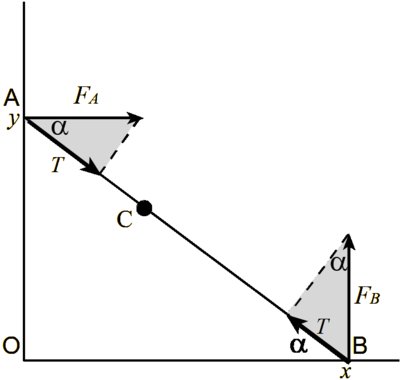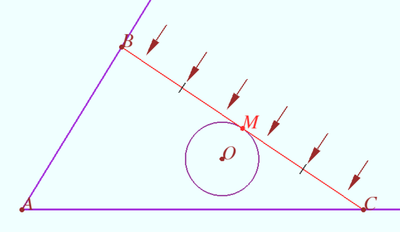Polya’s method for extremums
The segment of the shortest length
The segment ![]() has the ends on the sides of a right angle and contains a point
has the ends on the sides of a right angle and contains a point ![]() Find the shortest length of such a segment.
Find the shortest length of such a segment.
Solution
Let's imagine that ![]() is a spring rod that cannot bend, but tends to shorten its length.
is a spring rod that cannot bend, but tends to shorten its length.
The rod is fixed at point ![]() on a hinge without friction. The hinge allows the rod to rotate and slide.
on a hinge without friction. The hinge allows the rod to rotate and slide.
The ends of the rod can slide without friction along the grooves - the sides of the corner.
Let the rod be balanced, and the force pulling it together is equal to ![]() The grooves can create a force only along the normal, so they act on the rod with forces
The grooves can create a force only along the normal, so they act on the rod with forces
![]() For the rod to be balanced, it is required that the moments of the forces be equal relative to point
For the rod to be balanced, it is required that the moments of the forces be equal relative to point ![]() The moments of forces are:
The moments of forces are:
![]()
![]()
![]() vladimir.shelomovskii@gmail.com, vvsss
vladimir.shelomovskii@gmail.com, vvsss
The circle inside a fixed plane angle
Let the plane angle with vertex ![]() and the circle inside the angle be given. A straight line is drawn through point M of this circle, tangent to the circle and intersecting the sides of the angle at points
and the circle inside the angle be given. A straight line is drawn through point M of this circle, tangent to the circle and intersecting the sides of the angle at points ![]() and
and ![]() Find the condition under which the area of
Find the condition under which the area of ![]() is the smallest.
is the smallest.
Solution
Let us imagine that ![]() is a rod that cannot bend, and whose ends slide freely along the sides of the angle, and at point
is a rod that cannot bend, and whose ends slide freely along the sides of the angle, and at point ![]() it rests on a convex curve.
it rests on a convex curve.
Let ![]() be covered with a soap film, which, as usual, tends to reduce its area proportional to the energy.
Let ABC be a section of a triangular prism, two faces of which AB and AC are fixed, and the third (BC) is a piston whose width can be changed so that it fits hermetically to the faces AB and AC and can slide along them. The piston rests on a cylinder whose cross-section is a circle with center O.
be covered with a soap film, which, as usual, tends to reduce its area proportional to the energy.
Let ABC be a section of a triangular prism, two faces of which AB and AC are fixed, and the third (BC) is a piston whose width can be changed so that it fits hermetically to the faces AB and AC and can slide along them. The piston rests on a cylinder whose cross-section is a circle with center O.
Air has been removed from the prism. External air presses on the piston and it comes to an equilibrium position. In this case, the energy of the system will be minimal if the volume of the prism becomes minimal.
In the equilibrium position, the moments of forces applied to the piston ![]() on the segments
on the segments ![]() and
and ![]() are equal.
These moments are proportional to the square of the length of the segment, that is, the equilibrium condition is the equality
are equal.
These moments are proportional to the square of the length of the segment, that is, the equilibrium condition is the equality ![]() or
or ![]() is the midpoint
is the midpoint ![]() (the center of mass of a homogeneous segment
(the center of mass of a homogeneous segment ![]() )
)
vladimir.shelomovskii@gmail.com, vvsss
The sphere inside a fixed trihedral angle
There is a sphere inside a fixed trihedral angle with vertex ![]() A plane is drawn through point
A plane is drawn through point ![]() of this sphere, tangent to the sphere and intersecting the edges of the angle at points
of this sphere, tangent to the sphere and intersecting the edges of the angle at points ![]() and
and ![]()
Find the condition under which the volume of the pyramid ![]() is the smallest.
is the smallest.
Solution
Let us imagine the plane ![]() in the form of the piston covering the evacuated volume
in the form of the piston covering the evacuated volume ![]() There is no friction of the piston against the walls.
There is no friction of the piston against the walls.
In the equilibrium position, the volume of the evacuated part of the system is minimal. The equilibrium condition is the equality of the moments of pressure forces, which is equivalent to the equality of the moments of gravity for a homogeneous plate ![]() So the point
So the point ![]() of the contact with the sphere (or any convex solid) must be at the center of mass of the polygon
of the contact with the sphere (or any convex solid) must be at the center of mass of the polygon ![]()
vladimir.shelomovskii@gmail.com, vvsss











